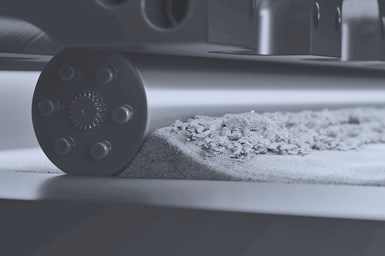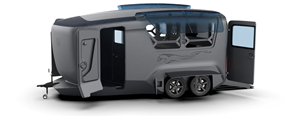AMGTA Research Demonstrates Sustainable Benefits of Binder Jet 3D Printing
Research from the Yale School of the Environment shows substantial reduction in GHG over traditional casting methods.
A research study commissioned by the Additive Manufacturer Green Trade Association (AMGTA), a global advocacy group focused on promoting sustainable additive manufacturing (AM) industry practices, indicates a dramatic reduction in greenhouse gas (GHG) emissions through AM compared to traditional manufacturing.
The research for the life cycle analysis study is titled, “Comparative Life-Cycle Assessment: Comparison of Casting vs. Binder Jetting for an Industrial Part.” The study was commissioned by the AMGTA and conducted by the Yale School of the Environment (YSE) in partnership with Desktop Metal and Trane Technologies.
The study analyzed a steel scroll chiller in an HVAC system from Trane to determine the comparative manufacturing impact of binder jet 3D printing versus traditional metal casting. The preliminary results confirmed a dramatic 38% reduction in greenhouse gas (GHG) emissions through the binder jetting process, primarily driven by reduced energy demand during the production phase.
With this study, the group is able to quantify the reduced energy demand of binder jetting versus traditional casting while possibly providing some surprises in the negligible impact offered by lightweighting in this specific use case.
“Prior to this project, uncertainty about the life cycle emissions of binder jetting versus conventional manufacturing approaches was a barrier to AM adoption,” says Kevin Klug, lead additive manufacturing engineer for Trane Technologies. “With the results of this study, Trane Technologies is in a better position to comprehensively consider AM's cost, productivity and environmental impact earlier in a product’s design cycle, when risk is lowest, and the potential benefits are highest.”
Key takeaways from the study include:
- Significant Reduction in Greenhouse Gas Emissions. The additive process showed a 38% reduction in greenhouse gas emissions based on binder jetting as compared to traditional casting for the parts studied.
- Importance of Energy Mix. Similar to previous findings, the study found that the manufacturing facility’s energy mix at the location of generation, and whether that energy grid was produced using sustainable means, had a significant impact on GHG emissions.
- Negligible Value of Redesign for Lightweighting. The study found that the potential benefits of redesigning the scroll chiller for lightweighting using a lattice-type structure were insignificant with respect to GHG emissions. The overall dimensions of the parts being produced, and the efficient use of print volumes, played a much more important factor than lightweighting. Lightweighting may provide environmental benefits in the use phase which is not included in this study.
- Material Production Impacts. While this study showed the environmental impacts of source powder production were approximately twice that for casting steel, such an increase represented a small portion of overall GHG emissions and did not play a significant role in the overall findings.
- Overall, Binder Jetting Produced a More Sustainable Part. The dramatic reduction of GHG emissions from energy demand by binder jetting versus traditional manufacturing was by far the most important finding of the YSE study.
“The release of these findings is significant for the AM industry and for companies in the broader manufacturing sector who are looking for more sustainable production methods,” says Sherri Monroe, AMGTA’s executive director. “With this study, we are able to quantify the reduced energy demand of binder jetting versus traditional casting, while possibly providing some surprises in the negligible impact offered by lightweighting in this specific use case.”
One of the drivers behind double-digit annual growth in AM over the past decade has been the adoption of binder jetting across multiple industries, driven by cost advantages, large-volume production and the potential for sustainability gains.
“We’re delighted to have another piece of independent, third-party research that validates how binder jetting is a greener approach to metal part production,” says Jonah Myerberg, Desktop Metal chief technology officer. “Harmful emissions from traditional metal manufacturing need to be lowered with innovative technology approaches, but manufacturers need sound data — not greenwashing — to make good choices about how they produce their metal products. This new study from Yale, Trane Technologies and AMGTA demonstrates what our team at Desktop Metal has long believed based on our hands-on experience: binder jetting is a greener way to manufacture metal parts.”
The two-year YSE study analyzed the cradle-to-gate manufacturing life cycle of a scroll set comprised of a fixed scroll and orbiting scroll manufactured by Trane Technologies as part of an HVAC system. The AMGTA commissioned the study in 2021 to better understand the potential for binder jetting to replace traditional sand casting as a more sustainable method of production. The study evaluated a traditional casting process followed by machining, plating and finishing steps in Mexico. The same scroll set design was evaluated through an additive binder jetting process of 3D printing, curing and sintering followed by the same plating and finishing steps in the same location in Mexico.
The results of the study showed a 38% reduction in GHG emissions for the AM process as compared to the traditional casting-based method. Due to the nature of the binder jetting, YSE’s researchers concluded that a redesign for lightweighting via a lattice-type structure may not necessarily lead to additional reductions in GHG emissions, primarily because the majority of electricity consumed related to printing, curing and sintering steps would not be impacted by lattice-type structures. The analysis suggests a 10% mass reduction in the scroll set would lead to a 1% reduction in GHG emissions.
Life cycle GHG emissions were significantly impacted by the local energy mix at the site of production. For this study, both the traditionally manufactured part set and the additively manufactured part set were evaluated at the same location with the same energy mix. Researchers also evaluated additional potential production locations and their corresponding energy mixes.
The findings indicate that such sensitivity to the grid “cleanness” needs to be considered when comparing AM with traditional processes to ensure a valid conclusion. While production in a more sustainable energy location provides environmental benefits for both production processes, the difference in environmental impacts between the methods diminishes as the energy mix becomes more “green.” Production volumes also play a significant role in GHG emissions of AM, especially for less efficient use of build volumes and small batch operations.
“Trane Technologies is committed to boldly challenging what’s possible for a sustainable world,” Klug adds. “That includes designing advanced climate control solutions that can be manufactured and operated with reduced environmental impact. Metal AM will become an increasingly viable tool in that pursuit, and binder jetting’s comparably higher speed and lower cost among AM technologies make it particularly promising for manufacturing HVAC components at relevant production volumes.”
This study is a clear win for manufacturers like Trane which are exploring more sustainable manufacturing options. “Binder jetting is a proven technology with clear and quantifiable advantages over traditional methods,” Monroe says. “We appreciate Trane’s leadership in pursuing more sustainable practices, their participation in this study, their willingness to share their processes and data, and interest in sharing this information with the broader manufacturing community.”
Highlights from the study and others can be found on the AMGTA website, with full results expected to be published in early 2024 following a peer review process. The AMGTA says it expects to publish additional independent research throughout 2023.
- Listen to this episode of AM Radio as Dr. Tim Simpson and Stephanie Hendrixson discuss current research and future opportunities on AM Radio, including results from the AMGTA life cycle assessment of an aerospace bracket.
- Read about AMGTA’s report on process to safely transport, recycle metal powder condensate waste. The process was developed by KBM Advanced Materials and Sintavia to passivate metal condensate in a removable resin enabling safe transport and recycling.
Related Content
Sustainable Furniture Company Model No. Maintains Product Focus with Switch from DIY to Industrial 3D Printers
The startup founded in 2018 has matured in its product offerings as well as its manufacturing equipment, moving from homegrown 3D printers to industrial large-format machines.
Read MoreNext-Gen Horse Trailers to Be Built With Robotic 3D Printing
Double D Trailers is currently developing a prototype horse trailer that will be made with large-format additive manufacturing. The technology brings potential benefits for labor, weight and design features to this subset of recreational vehicles.
Read MoreEvaluating the Printability and Mechanical Properties of LFAM Regrind
A study conducted by SABIC and Local Motors identified potential for the reuse of scrap reinforced polymer from large-format additive manufacturing. As this method increases in popularity, sustainable practices for recycling excess materials is a burgeoning concern.
Read MoreVideo: A Mechanical Method for Metal Powder Production
Metal Powder Works has developed a method for producing powders from solid barstock, no melting required. This video covers how the process works and benefits of mechanical production of powders.
Read MoreRead Next
Alquist 3D Looks Toward a Carbon-Sequestering Future with 3D Printed Infrastructure
The Colorado startup aims to reduce the carbon footprint of new buildings, homes and city infrastructure with robotic 3D printing and a specialized geopolymer material.
Read MoreCrushable Lattices: The Lightweight Structures That Will Protect an Interplanetary Payload
NASA uses laser powder bed fusion plus chemical etching to create the lattice forms engineered to keep Mars rocks safe during a crash landing on Earth.
Read More3D Printed Polymer EOAT Increases Safety of Cobots
Contract manufacturer Anubis 3D applies polymer 3D printing processes to manufacture cobot tooling that is lightweight, smooth and safer for human interaction.
Read More





















